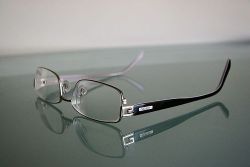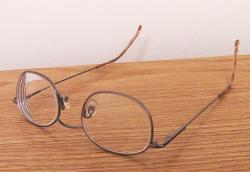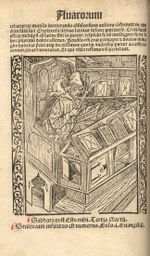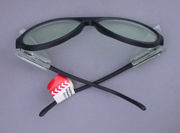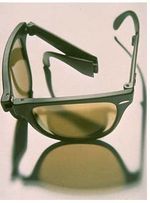Glasses
2007 Schools Wikipedia Selection. Related subjects: Engineering
Glasses, spectacles, or eyeglasses are frames bearing lenses worn below the forehead and in front of the human eyes, sometimes for purely aesthetic reasons but normally for vision correction or eye protection or for protection from UV rays. Special glasses are used for viewing three-dimensional images from two-dimensional displays or experiencing virtual reality.
Modern glasses are typically supported by pads on the bridge of the nose and by temples placed over the ears. Historical types include the pince-nez, monocle, and lorgnette.
Lenses were originally made from glass, but many are now made from various types of plastic, including CR-39 or polycarbonate. These materials reduce the danger of breakage and the greater weight of glass lenses. Some plastics also have more advantageous optical properties than glass, such as better transmission of visible light and greater absorption of ultraviolet light. Some plastics have a greater index of refraction than most types of glass; this is useful in the making of corrective lenses shaped to correct vision abnormalities such as myopia, allowing thinner lenses for a given prescription. Scratch-resistant coatings can be applied to most plastic lenses giving them similar scratch resistance to glass. Hydrophobic coatings designed to ease cleaning are also available, as are anti-reflective coatings intended to improve night vision and make the wearer's eyes more visible.
Polycarbonate lenses are the lightest and most shatterproof, making them the best for impact protection. Polycarbonate lenses offer poor optics because of a low Abbe value of 31. CR-39 lenses are the most common plastic lenses, due to their low weight, high scratch resistance and low transparency for ultra violet and infared radiation.
Some glasses are not designed for vision correction. Safety glasses are a kind of eye protection against flying debris or against visible and near visible light or radiation. Sunglasses allow better vision in bright daylight, and may protect against damage from high levels of ultraviolet light.
History
The first recorded use of a corrective lens was by the emperor Nero, who was known to watch the gladiatorial games using an emerald.
Sunglasses were first used in China in the 12th century or possibly earlier. The "lenses" of these glasses were flat panes of smoky quartz, which offered no corrective powers but did protect the eyes from glare.
Glasses first began to appear in common use in northern Italy late in the 13th century; most likely in the late 1280s. It is not clear when the technology was invented. It has been said that Marco Polo reported seeing many pairs of glasses in China as early as 1275. In 1676, Franciscus Redi, a professor of medicine at the University of Pisa, wrote that he possessed a 1289 manuscript whose author complains that he would be unable to read or write were it not for the recent invention of glasses, and a record of a sermon given in 1305, in which the speaker, a Dominican monk named Fra Giordano da Rivalto, remarked that glasses had been invented less than twenty years previously, and that he had met the inventor. Based on this evidence, Redi credited another Dominican monk, Fra Alessandro da Spina of Pisa, with the re-invention of glasses after their original inventor kept them a secret, a claim contained in da Spina's obituary record.
In 1738, a Florentine historian named Domenico Manni reported that a tombstone in Florence credited one Salvino d'Armato (died 1317) with the invention of glasses. Other stories, possibly legendary, credit Roger Bacon with the invention. Bacon's published writings describe the magnifying glass (which he did not invent), but make no mention of glasses. His treatise De iride ("On the Rainbow"), which was written while he was a student of Robert Grosseteste, no later than 1235, mentions using optics to "read the smallest letters at incredible distances".
These early spectacles had convex lenses that could correct the presbyopia (farsightedness) that commonly develops as a symptom of aging. Nicholas of Cusa is believed to have discovered the benefits of concave lens in the treatment of myopia (nearsightedness). However, it was not until 1604 that Johannes Kepler published in his treatise on optics and astronomy, the first correct explanation as to why convex and concave lenses could correct presbyopia and myopia.
The American scientist Benjamin Franklin, who suffered from both myopia and presbyopia, invented bifocals in 1784 to avoid having to regularly switch between two pairs of glasses. The first lenses for correcting astigmatism were constructed by the British astronomer George Airy in 1827.
Over time, the construction of spectacle frames also evolved. Early eyepieces were designed to be either held in place by hand or by exerting pressure on the nose (pince-nez). Girolamo Savonarola suggested that eyepieces could be held in place by a ribbon passed over the wearer's head, this in turn secured by the weight of a hat. The modern style of glasses, held by temples passing over the ears, was developed in 1727 by the British optician Edward Scarlett. These designs were not immediately successful, however, and various styles with attached handles such as scissors glasses and lorgnettes remained fashionable throughout the 18th and into the early 19th century.
In the early 20th century, Moritz von Rohr at Zeiss (with the assistance of H. Boegehold and A. Sonnefeld ), developed the Zeiss Punktal® spherical point-focus lenses that dominated the eyeglass lens field for many years.
Despite the increasing popularity of contact lenses and laser corrective eye surgery, glasses remain very common and their technology has not stood still. For instance, it is now possible to purchase frames made of special memory metal alloys that return to their correct shape after being bent. Other frames have spring-loaded hinges. Either of these designs offers dramatically better ability to withstand the stresses of daily wear and the occasional accident. Modern frames are also often made from strong, light-weight materials such as titanium alloys, which were not available in earlier times.
Types
Corrective
Corrective lenses modify the focal length of the eye to alleviate the effects of nearsightedness (myopia), farsightedness (hyperopia) or astigmatism. As people age the eye's crystalline lens loses elasticity resulting in presbyopia, which limits their ability to change focus.
The power of a lens is generally measured in diopters. Over-the-counter reading glasses are typically rated at +1.00 to +3.00 diopters. Glasses correcting for myopia will have negative diopter strengths. Lenses made to conform to the prescription of an ophthalmologist or optometrist are called prescription lenses and are used to make prescription glasses.
Safety
Safety glasses are usually made with shatter-resistant plastic lenses to protect the eye from flying debris. Although safety lenses may be constructed from a variety of materials that vary in impact resistance, certain standards suggest that they maintain a minimum 1 millimeter thickness at the thinnest point, regardless of material. Safety glasses can vary in the level of protection they provide. For example, those used in medicine may be expected to protect against blood splatter while safety glasses in a factory might have stronger lenses and a stronger frame with additional shields at the temples. The lenses of safety glasses can also be shaped for correction.
Some safety glasses are designed to fit over corrective glasses or sunglasses. They may provide less eye protection than goggles, face shields or other forms of eye protection, but their light weight increases the likelihood that they will actually be used. Recent safety glasses have tended to be given a more stylish design, in order to encourage their use. The pictured wraparound safety glasses are evidence of this style change with the close fitting nature of the wraparound dispensing with the need for side shields. Corrective glasses with plastic lenses can be used in the place of safety glasses in many environments; this is one advantage that they have over contact lenses.
There are also safety glasses for welding, which are styled like wraparound sunglasses, but with much darker lenses, for use in welding where a full sized welding helmet is inconvenient or uncomfortable. These are often called "flash goggles", because they provide protection from welding flash).
Nylon frames are usually used for protection eyewear for sports beacause of their lightweight and flexible properties. They are able to bend slightly and return to their original shape instead of breaking when pressure is applied to them. Nylon frames can become very brittle with age and they can be difficult to adjust.
Sunglasses
Sunglasses may be made with either prescription or non-prescription lenses that are darkened to provide protection against bright visible light. Good sunglasses should also protect against ultraviolet light. Because of changes in the atmosphere, ultraviolet levels are much higher than in the past and ultraviolet protection for eyes and skin is even more important. It is possible to have lenses that look very dark and yet offer little ultraviolet protection. Sunglasses vary greatly and many offer more style than protection.
Glasses with photosensitive lenses, called photochromic lenses, become darker in the presence of UV light. Unfortunately, many car windshields protect the passengers from UV light while not shielding from bright visible light, making photochromic lenses ineffective where they are most needed. Still, they offer the convenience of not having to carry both clear glasses and sunglasses to those who frequently go indoors and outdoors during the course of a day.
Light polarization is an added feature that can be applied to sunglass lenses. Polarization filters remove horizontal rays of light, which can cause glare. Popular among fishermen and hunters, polarized sunglasses allow wearers to see into water when normally glare or reflected light would be seen. Polarized sunglasses may present some difficulties for pilots since reflections from water and other structures often used to gauge altitude may be removed, or instrument readings on liquid crystal displays may be blocked.
Yellow lenses are commonly used by golfers and shooters for its contrast enhancement and depth perception properties. Brown lenses are also common among golfers, but cause colour distortion. Blue, purple, and green lenses offer no real benefits to vision enhancement and are mainly cosmetic. Some sunglasses with interchangeable lenses have optional clear lenses to protect the eyes during low light or night time activities and a colored lense with UV protection for times where sun protection is needed. Debate exists as to whether "blue blocking" or amber tinted lenses have a protective effect.
Sunglasses are often worn just for aesthetic purposes, or simply to hide the eyes. Examples of sunglasses that were popular for these reasons include teashades and mirrorshades.
Special
The illusion of three dimensions on a two dimensional surface can be created by providing each eye with different visual information. Classic 3D glasses create the illusion of three dimensions when viewing specially prepared images. The classic 3D glasses have one red lens and one blue lens. 3D glasses made of cardboard and plastic are distributed at 3D movies. Another kind of 3D glasses uses polarized filters, with one lens polarized vertically and the other horizontally, with the two images required for stereo vision polarized the same way. The polarized 3D specs allow for colour 3D, while the red-blue lenses produce a dull black-and-white picture with red and blue fringes.
One kind of electronic 3D spectacles uses electronic shutters.
Virtual reality glasses and helmets have separate video screens for each eye and a method for determining the direction the head is turned.
Variations
Glasses can be very simple. Magnifying lenses for reading that are used to treat mild hypermetropia and presbyopia can be bought off the shelf, but most glasses are made to a particular prescription, based on degree of myopia or hypermetropia combined with astigmatism. Lenses can be ground to specific eyes, but in most cases standard off-the-shelf prescriptions suffice, but require custom fitting to particular frames.
As people age, their ability to focus is lessened and many decide to use multiple-focus lenses, bifocal or even trifocal to cover all the situations in which they use their sight. Traditional multifocal lenses have two or three distinct viewing areas, each requiring a conscious effort of refocusing. These were originally separate lenses, as invented by Benjamin Franklin.
Some modern multifocal lenses give a smooth transition between these lenses, unnoticeable by most wearers. Others have lenses specifically intended for use with computer monitors at a fixed distance. Many people have several pairs of glasses, one for each task or distance, with specific glasses for reading, computer use, television watching, and writing.
Fashion
Glasses are often regarded as unattractive, and many people prefer to wear contact lenses for that reason. Contact lenses also provide much improved peripheral vision.
On the other hand, many people are attracted to people who wear glasses, and glasses are available in a wide range of styles, materials, and even designer labels.
Glasses can be a major part of personal expression, from the extravagance of Elton John and Dame Edna Everage, from Groucho Marx to Woody Allen to John Denver to Drew Carey to Lisa Loeb all the way to the varied professional personas of eyeglass-wearing knowledge workers.
For some celebrities, glasses form part of their identity. American Senator Barry Goldwater continued to wear lensless horn-rimmed spectacles after being fitted with contact lenses because he was not recognizable without his trademark glasses. British soap star Anne Kirkbride had the same problem: her character on Coronation Street, Deirdre Barlow, became so well-known for her big frames that she was expected to wear them at social gatherings and in international tours, even though Kirkbride has always worn contact lenses. Drew Carey continued to wear glasses for the same reason after getting corrective laser eye surgery. British comedic actor Eric Sykes, who became profoundly deaf as an adult, wears glasses that contain no lenses; they are actually a bone-conducting hearing aid. Masaharu Morimoto wears glasses to separate his professional persona as a chef from his stage persona as Iron Chef Japanese. John Lennon wore his round "granny glasses" from some of his time with the Beatles to his assassination in 1980.
In popular culture, glasses were all the disguise Superman and Wonder Woman needed to hide in plain view as alter egos Clark Kent and Diana Prince, respectively. An example of halo effect is seen in the stereotype that those who wear glasses are intelligent or, especially in teen culture, even geeks and nerds. Some people who find that wearing glasses may look nerdy turn to contact lenses instead, especially under peer pressure.
Another unpopular aspect of glasses is their inconvenience. Even through the creation of light frames, such as those made of titanium, very flexible frames, and new lens materials and optical coatings, glasses can still cause problems during rigorous sports. The lenses can become greasy or trap vapour when eating hot food, swimming, walking in rain or rapid temperature changes (such as walking into a warm building from cold temperatures outside), reducing visibility significantly. Scraping, fracturing, or breakage of the lenses require time-consuming and costly professional repair, though modern plastic lenses are almost indestructible and very scratch-resistant.
Other names
- Pair of glasses (or just glasses) is commonly used in Britain and in North America. Compare with other meanings of the word glass.
- Spectacles is widely used in Britain and occasionally in the U.S., in addition to use by professional opticians. Also in frequent use is the shortened form, specs.
- Eye glasses or eyeglasses is a word used in North American English. In contrast, glass eye refers to a cosmetic prosthetic artificial eye that replaces a missing eye.
- Frames is sometimes used to refer to framed eyepieces, although it is not common.
- Lenses is also sometimes used to refer to framed eyepieces, although it is not common.
- Cheaters is used in the hipster argot. Eyeglasses were a common part of the hipster persona, for example Dizzy Gillespie.
